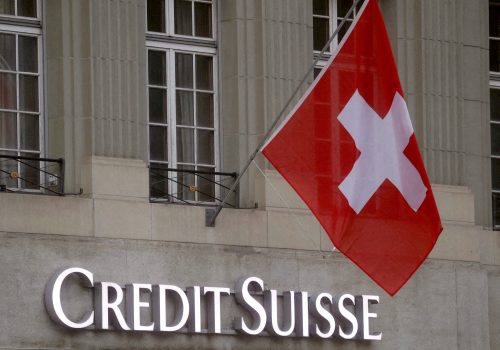The US debt ceiling stalemate threatens money market funds—and financial stability
The current crisis among US regional banks has caused a huge outflow of bank deposits to money market funds (MMFs) offering higher interest rates. But MMFs are exposed to one of the greatest risks currently facing the global economy: the possibility that the US breaches its debt ceiling and defaults on its debt.
Over the past year, bank deposits fell by almost $1 trillion while assets under management (AUM) of the MMFs increased by $700 billion. MMFs were growing before the banking turmoil, too: AUM has increased by $1.7 trillion since the beginning of 2020, to $5.7 trillion at present. Since MMFs largely invest in US Treasury bills, their status as a safe and attractive alternative to bank deposits would be threatened if the national debt ceiling stalemate cannot be resolved in time. A debt ceiling breach would put in doubt the government’s ability to meet its obligations, as soon as June 1. This is known as the X-date when the Treasury Department will have exhausted all extraordinary measures to avoid breaching the $31.4 trillion debt ceiling. Even if the stalemate is resolved at the last moment, as market participants currently expect, the increase in the probability of government default would elevate uncertainty and further unsettle financial markets which have already been under stress. The tail-end risk of a messy and prolonged debt ceiling stalemate is higher this time around than previously—and money markets will be the first to react if a deal isn’t reached in time.
Why money market funds are at risk
MMFs are vulnerable to disruptions in the Treasury market since they hold a lot of Treasury bills. In particular, government MMFs—with $4.4 trillion in AUM—split their portfolios almost evenly between Treasury bills and lending to the Fed via the Overnight Reverse Repo facility. Under this facility, MMFs can lend money to the Fed on an overnight basis, taking US Treasury securities as collateral and agreeing to sell them back at predetermined rates. The Fed reserve repo facility has grown substantially in recent years, reaching $2.2 trillion in volume at present.
As the X-date approaches, one-year US sovereign Credit Default Swap (CDS) spreads (equivalent to the insurance premiums investors pay for protection against default) have jumped to more than 160 basis points—a record high compared to less than 20 basis points during normal times. That exceeds the CDS spreads for Mexico, Brazil and Greece. Investors have also avoided T-bills maturing right after the X-date, pushing up their yields. For example, at the latest auction on May 4, yields on one-month T-bills maturing on June 6 jumped to 5.76 percent, or 240 basis points higher than two weeks ago. Such a sharp and abrupt increase in yields has reduced the prices of fixed income instruments like T-bills, leading to mark-to-market losses at MMFs. Depending on their portfolio composition and risk management practices, some MMFs could suffer losses noticeable enough to discomfort their clients who expect stable values of these funds.
Furthermore, if the debt ceiling is not raised in time to avoid default, the US credit rating would be downgraded to Restricted Default (RD) and affected Treasury securities would carry a D rating until the default is cured. Even if the government prioritizes the servicing of its debt ahead of other obligations to avoid default—a politically controversial move—that would not be consistent with an AAA rating. One major agency, S&P, already downgraded the US in 2011.
In short, possible mark-to-market losses and credit downgrades of Treasury securities, the main assets held by MMFs, would generate anxiety among MMF clients, probably prompting some to move their money elsewhere. (Much of it might flow to the top banks, further accelerating the consolidation of the US banking system.) While any outflow could be dampened to some extent by the gating arrangements and liquidity fees employed by MMFs to manage the outflow in an orderly way, this would nevertheless heighten uncertainty and a sense of nervousness in financial markets already struggling to cope with the regional banking crisis, high interest rates, and a credit crunch. Adding a run on MMFs to heighten market turmoil might trigger a more severe recession than hitherto expected. For that reason, the negative financial and economic impacts of the current debt ceiling stalemate could be more substantial than those of the previous episodes in 2011 and 2013.
Uncertainty at just the wrong time
MMFs can respond to the uncertainty surrounding the status of Treasury bills after the X-date by lending more to the Fed through the reverse repo facility, whose daily volume could rise substantially in the weeks ahead. However, the more MMFs lend to the Fed, the more liquidity is being withdrawn from the financial system, compounding the effects of Quantitative Tightening (QT) which the Fed has been implementing since June 2022 to reduce its holding of government securities by $95 billion per month. This would make it more difficult to assess the overall effects of the Fed’s tightening policy stance—both for the Fed itself and for market participants, elevating uncertainty about future economic prospects.
The political wrangling over the national debt ceiling has heightened uncertainty at the wrong time and is helping to raise the odds of a severe recession. Beyond the near-term outlook, the recurrence of the debt ceiling “mini crises” would erode the reliability, predictability, and trustworthiness of the US government—possibly causing it to eventually lose its AAA rating and raising its funding costs. More fundamentally, the practice of using the debt ceiling as a political tool to change or terminate federal programs approved by previous Congresses reflects bad governance in the US—notwithstanding the fact that the US public debt/GDP ratio is too high and needs to be reduced over time. The inability of the US to adopt a sustainable fiscal policy in an orderly manner will exact an increasingly noticeable cost by diminishing the efficiency and credibility of the US government, with negative implications for the whole economy.
Hung Tran is a nonresident senior fellow at the Atlantic Council’s GeoEconomics Center, a former executive managing director at the Institute of International Finance and former deputy director at the International Monetary Fund.

At the intersection of economics, finance, and foreign policy, the GeoEconomics Center is a translation hub with the goal of helping shape a better global economic future.
Further reading
Mon, Mar 20, 2023
The US debt limit is a global outlier
Econographics By Mrugank Bhusari
Debt limits are not the norm in public finance. But countries that have adopted them do not let them cause economic chaos.
Wed, Mar 15, 2023
Bailouts create a moral hazard even if they are justified. Is there another way?
New Atlanticist By Hung Tran
The US guarantee for Silicon Valley Bank and possible Swiss intervention for Credit Suisse raise important questions. Here's one alternative approach for large depositors.
Wed, Apr 19, 2023
These reforms can help stop digital bank runs
New Atlanticist By Hung Tran
Policymakers should start by reforming the liquidity coverage ratio requirement and the deposit insurance scheme.
Image: Black and white moody image of the US Capitol


